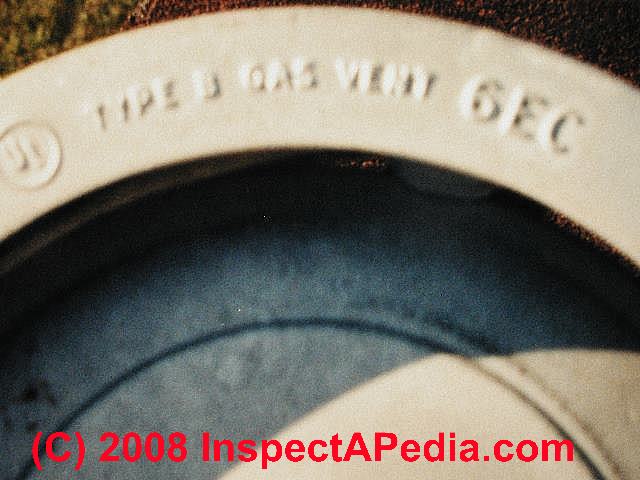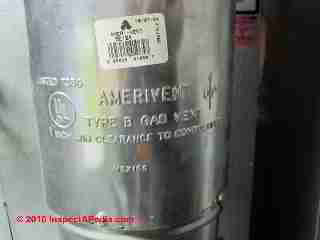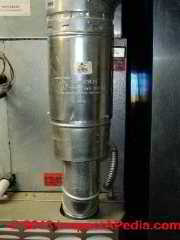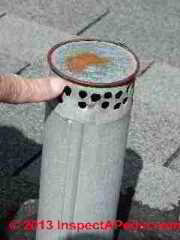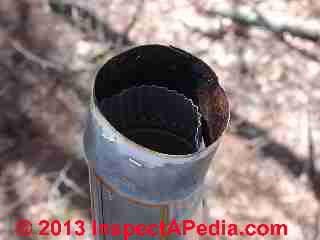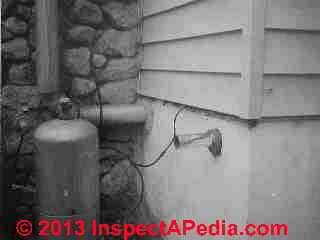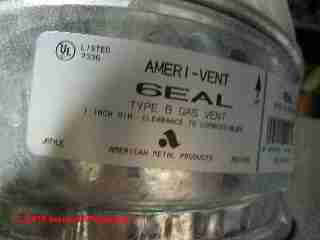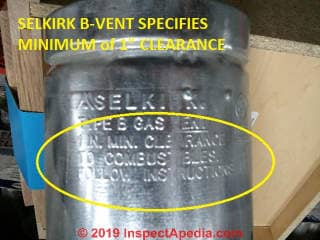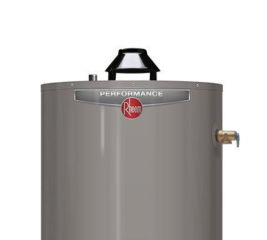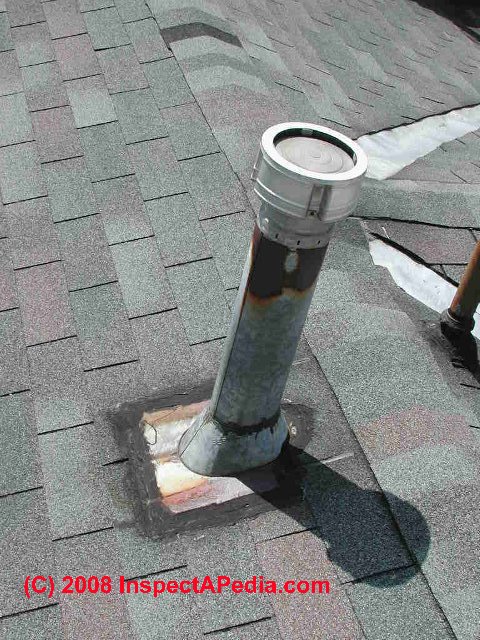 Type B-Vents for Gas Fired Appliances
Type B-Vents for Gas Fired Appliances
Specifications for use of Type B gas vents, unsafe Type B vents, B-Vent fire clearances
- POST a QUESTION or COMMENT about B-vents chimneys & flues: installation specifications
Metal B-Vent flue installation requirements & inspection suggestions.
This article describes B-vent metal chimneys used for gas-fired appliances. What are Type B vents and where are they used? B-vents for gas fired appliances are explained. We include photos of B-vent markings & labels for identification.
We give chimney cap requirements for B-vents and we discuss fire safety, fire clearances, and other gas appliance venting details for metal B-vent chimneys
InspectAPedia tolerates no conflicts of interest. We have no relationship with advertisers, products, or services discussed at this website.
- Daniel Friedman, Publisher/Editor/Author - See WHO ARE WE?
Type B-Vents for Gas Fired Appliances
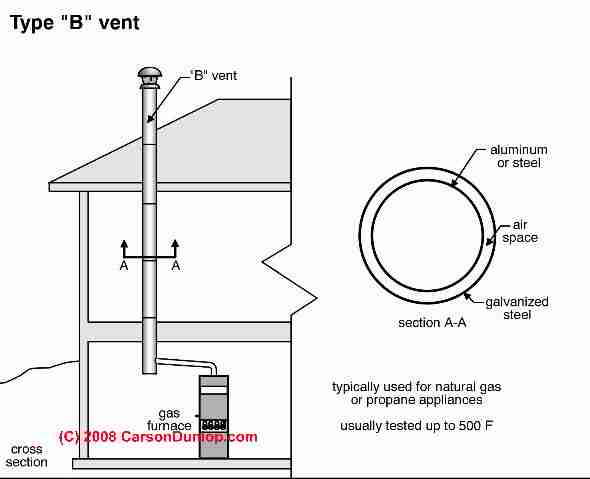
Type B-vents are double-walled metal chimneys/flues and can be used only with listed, draft-hood equipped gas appliances.
Type B gas vents such as the Ameri-Vent™ are permitted for venting gas-fired appliances and have their own set of combustible clearance and installation specifications.
A Type B vent is intended for relatively low-heat applications.
B-vents are not permitted for use with incinerators and are not intended for use with appliances burning anything other than LP or natural gas.
Watch out: B-Vents are not for use with fireplaces, woodstoves, or oil-fired equipment.
As you see in our close-up photo below, a rated or UL-listed type B-vent chimney will usually be clearly labeled.
The B-vent also requires that its own special chimney cap be installed.
If the cap is lost, do not substitute something not recommended by the manufacturer or the chimney may be unsafe.
Watch out: also for a "home made" B-vent using aluminum or clothes dryer venting products. Those are not intended for venting gas appliances and would be unsafe in such use.
B-Vent Chimney Outdoor Temperature Limits
Question: B-Vent outdoor temperature limits
Can B-Vent be used as an exterior chimney in New York where temps reach 10 below? - Edward J Foley 2022/04/28
This Q&A were posted originally
at TYPE B-VENT ROOFTOP CLEARANCE
Moderator reply: recommendation: insulated chimney chase for tall outdoor B-Vent chimneys in very cold climates
NO, that is, probably not without an enclosing and insulated chimney chase. Also check with your local building department about what's permitted and safe where you live.
New York 2020 Fuel Gas Code (based on the 2018 International Fuel Gas Code) states the following:
503.7.2 Cold Climate
Uninsulated single-wall metal pipe shall not be used outdoors for venting appliances in regions where the 99-percent winter design temperature is below 32°F (0°C).
504.2.9 Chimney and vent locations.
Tables 504.2(1), 504.2(2), 504.2(3), 504.2(4) and 504.2(5) shall be used only for chimneys and vents not exposed to the outdoors below the roof line. A Type B vent or listed chimney lining system passing through an unused masonry chimney flue shall not be considered to be exposed to the outdoors.
Where vents extend outdoors above the roof more than 5 feet (1524 mm) higher than required by Figure 503.6.5, and where vents terminate in accordance with Section 503.6.5, Item 2, the outdoor portion of the vent shall be enclosed as required by this section for vents not considered to be exposed to the outdoors or such venting system shall be engineered.
A Type B vent shall not be considered to be exposed to the outdoors where it passes through an unventilated enclosure or chase insulated to a value of not less than R8.
Details:
While it's often permissible to extend the B-vent chimney from the building interior to its exterior, and while we see that illustrated in typical installation instructions, that's not the end of the question about exposure of a B-vent to low outdoor temperatures.
Watch out: B-vent chimney manufacturers may provide different instructions for their products, some permitting the use of the B-vent outside with no chimney chase and others requiring that the chimney be enclosed in a chaseway until it reaches the rooftop height.
The concern - which I am guessing you suspect as well - is that at very low outdoor temperatures the draft inside the B-vent chimney flue could be insufficient.
The result risks production and release of fatal carbon monoxide gas in the building served by the heating equipment thus vented.
There could also be a problem of corrosion or equipment damage from high levels of condensate forming in the very cold flue, or even frost formation near the chimney top, blocking or obstructing the venting of flue gases in extremely cold climates.
In reading literature about type B Vent chimneys we often find manufacturers or literature noting that a chimney chase may be needed in cold climates to assure adequate and safe draft.
A Type B-vent chimney
Receives incoming flue gases in the 400 - 480°F (249°C) - that's the temperature of combustion gases entering the chimney
The B-vent's exterior surface is designed to not exceed 90°F - thus meeting fire clearance and safety code requirements, but it does so with an air space between an inner and outer metal flue.
Contrast that with other more-insulated chimneys such as Class-A Chimneys whose construction involves an insulator
see CLASS A CHIMNEYS, MetalBestos™
Building Code Requirements for Outdoor Use of B-Vent Chimneys
Excerpt from the New York State Code
[The underscore emphasis is ours - Ed.] - Note that these are excerpts, not the entire code.
503.7.2 [Single-Wall Metal Chimneys in ] Cold Climate
Uninsulated single-wall metal pipe shall not be used outdoors for venting appliances in regions where the 99-percent winter design temperature is below 32°F (0°C).
503.10.2.2 Vent Connectors Located in Unconditioned Areas
Where the vent connector used for an appliance having a draft hood or a Category I appliance is located in or passes through attics, crawl spaces or other unconditioned spaces, that portion of the vent connector shall be listed Type B, Type L or listed vent material having equivalent insulation properties.
Exception:
Single-wall metal pipe located within the exterior walls of the building in areas having a local 99-percent winter design temperature of 5°F (-15°C) or higher shall be permitted to be used in unconditioned spaces other than attics and crawl spaces.
504.2.9 [B-Vent ] Chimney and vent locations.
Tables 504.2(1), 504.2(2), 504.2(3), 504.2(4) and 504.2(5) shall be used only for chimneys and vents not exposed to the outdoors below the roof line.
[Note: for Type B-Vent chimneys see TABLE 504.3(1) TYPE B DOUBLE-WALL VENT - Ed]
A Type B vent or listed chimney lining system passing through an unused masonry chimney flue shall not be considered to be exposed to the outdoors.
Where vents extend outdoors above the roof more than 5 feet (1524 mm) higher than required by Figure 503.6.5, and where vents terminate in accordance with Section 503.6.5, Item 2, the outdoor portion of the vent shall be enclosed as required by this section for vents not considered to be exposed to the outdoors or such venting system shall be engineered.
A Type B vent shall not be considered to be exposed to the outdoors where it passes through an unventilated enclosure or chase insulated to a value of not less than R8.
Table 504.2(3) in combination with Table 504.2(6) shall be used for clay-tile-lined exterior masonry chimneys, provided that all of the following are met:
1. Vent connector is a Type B double wall.
2. Vent connector length is limited to 11/2 feet for each inch (18 mm per mm) of vent connector diameter.
3. The appliance is draft hood equipped.
4. The input rating is less than the maximum capacity given by Table 504.2(3).
5. For a water heater, the outdoor design temperature is not less than 5°F (-15°C).
6. For a space-heating appliance, the input rating is greater than the minimum capacity given by Table 504.2(6).
Source: 2020 Fuel Gas Code of new York State, based on the 2018 Inernational Fuel Gas Code, retrieved 2022/04/28 original source: https://codes.iccsafe.org/s/NYSFGC2020P1/chapter-5-chimneys-and-vents/NYSFGC2020P1-Ch05-Sec504.2.9
Note: The Fuel Gas Code Table 504.2 Application of Single-Appliance Vent Tables 504.2(1) Through 504.2(6)
provides required chimney heights for vents of various diameters given various appliance input BTUH rating (in thousands of BTUs/Hour) .
Type B Vent Installation Errors to Avoid
Get the Metal Chimney Sections Right-Way Up
Metal chimney assemblies, including Type B-Vents Includes a "right way up" which you can see Amerivent stamps or embosses right into the steel surface as well as marking it again on a printed label, giving us two chances to get it right.
Here is a close-up of the vent label: note the "up" arrow.
At below left you can see the Type B gas vent installed "right way up". Why is this important?
- If a gas vent is installed upside down there is risk of dangerous
CARBON MONOXIDE - CO gas leakage into the building - a potentially fatal mistake. - If a gas vent is installed upside down condensate leaks back into the heating appliance where it can cause expensive corrosion or rust damage, perforation, gas leakage, and expensive as well as dangerous conditions.
Use Type B Gas Vents Only On Gas Fired Equipment - not with other fuels
Type B gas vents are not to be used with incinerators or with appliances burning solid or liquid fuels. The gas vent is correctly installed here on a gas fired heater.
Below, [Click to enlarge] Ameri-Vent's Type B gas vent label makes plain that the vent is intended only for use with listed, draft-hood-equipped gas appliances.
Stupid Home-Made Gas Vent Tricks
Besides choosing the right chimney material for the appliance it is to vent, a safe installation follows applicable building codes and standards.
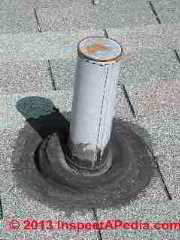 But the Type B vent manufacturers make a concerted effort to get their products installed correctly and safely even by fellows who prefer to use the instructions to kneel upon.
But the Type B vent manufacturers make a concerted effort to get their products installed correctly and safely even by fellows who prefer to use the instructions to kneel upon.
Well what can I say about this photo pair above and below ?
This creative "gas vent" and home made "chimney cap" had nothing right and nothing safe about it.
- The telescoping (though creative) cap had slid down into the vent, blocking exit venting,
- the diameter was too small, there was no rain cap,
- the material used for the gas vent was not listed for that purpose,
- a rubber plumbing vent is being used on what was supposed to be a glue gas vent where we expect metal flashing, and so on ad nauseam.
It is worth taking a look at all chimneys from time to time - perhaps to notice that a cap has been lost (below left) or other damage has occurred.
Below: a damaged DIY gas vent with no cap.
In our photo below that aluminum, horizontal pipe near the building corner is venting a gas fired water heater. Or is it? At the stone wall we see a second larger B-type gas vent for the heating system.
Type B Vent Chimney Labels & Identification
Our photos below show the common embossed and printed labels that identify Type B Gas vents.
In the photo just above and just below are labels and the UL listing mark on a Type B Gas Vent produced by Amerivent.
Below is a similar product produced by the Canadian manufacturer Selkirk.
Below I'm holding a new section of Selkirk's Type B gas vent to show its double-wall construction.
L-Vents vs B-Vents - What's the Difference?
As we state at TYPE L VENT CHIMNEYS, it can be confusing distinguishing between L-Vent chimneys and B-Vent chimneys, in part because the same components may be used in both heat venting range installations.
Type L-Vents conform to UL 641 and are intended for higher temperature applications such as venting oil fired heating equipment. A Type-L vent can also be used for venting a gas appliance as explained below.
Type B-Vents are intended for lower temperature gas fired heating equipment applications and should not be used with other fuels (such as home heating oil).
Describing their model DFS L-Vent/ Type B Gas Vent installation procedures, Selkirk Corporation, a producer of metal chimneys and vents, offers these details:
Type L-Vent is designed for venting approved oil or gas appliances producing draft hood flue gases not exceeding a temperature of 570ºF (299ºC).
Type B Gas vent is designed for venting approved gas appliances equipped with draft hoods and other Listed gas appliances specified for use with Type B Gas vent which produce flue gases not exceeding 480°F (249°C).
Note: some specific B-vent manufacturers may set a different maximum flue gas temperature. For example see Hart and Cooley's documentation given below and in which the company states
"Type B Gas Vent is designed for negative pressure applications and flue gas temperatures not exceeding 400°F above ambient for Category I appliances.".
Minimum clearance between the vent and combustible materials is 3 inches for L-Vent and 1 inch for Type B gas vent.
L-Vent or B-Vent that extends through any story above that on which the connected appliance is located is to be provided with enclosures having a fire resistance rating equal to or greater than that of the floor or roof assemblies through which they pass.
Framing dimensions of enclosures and at joist or rafter levels shall be a minimum of 6" larger than the outside of the vent for L-Vent and 2” larger for B-Vent.
Near the vent base, post a notice of the type of appliance for which the DFS installation to combustibles is installed. If installed at 1” airspace, it is limited to B-Vent (gas) only.
If it is installed at 3” airspace, it it may be used with oil (as an LVent) or gas (as a B-Vent).
Chimney & Vent Codes & Installation Manuals
- More details about Type B metal chimney fire clearances indoors can be read
at FIRE CLEARANCES, METAL CHIMNEYS [ web page] - CHIMNEY CODES [web page] complete list of online chimney code PDF files.
- CHAPTER 5, CHIMNEYS AND VENTS, SECTION 501 (IFGC), [PDF] (2015) Seattle building code, Retrieved 2017/07/22, original source: http://www.seattle.gov/dpd/cs/groups/pan/@pan/documents/web_informational/p2622099.pdf
- DuraVent, DuraFlex® AL INSTALLATION INSTRUCTIONS [PDF] (2017) M&G Duravent, Inc., Tel: 800-835-4429, Website: www.duravent.com,
Excerpt: Flexible aluminum relining system for relining masonry chimneys for natural gas or liquid propane category I, draft hood equipped appliances, and appliances tested and listed to use Type B gas vent. - Hart / Cooley TYPE B GAS VENT SIZING GUIDE [PDF] (2018) Hart & Cooley, LLC5030 Corporate Exchange Blvd. SE, Grand Rapids, MI 49512P USA (800) 433-6341F (800) 223-8461 Website: hartandcooley.com Retrieved 2020/09/30 original source: hartandcooley.com/assets/files/c3/hcb_010056_sizingguide_typeballfuelchimney_june2018.pdf
Hart & Cooley, TYPE B GAS VENT CHIMNEY FEATURES [PDF] Op. Cit., retrieved 2022/04/28, original source: hartandcooley.com/chimney-and-vent/type-b-vent-gas
Hart & Cooley, Inc., CHIMNEY & VENTING PRODUCT WARRANTY [PDF] HART & COOLEY, INC 5030 Corporate Exchange Blvd. SE Grand Rapids, Michigan 49512 ATTN: WARRANTY CLAIMS 1.800.433.6341, Fax: 1.800.223.8461 www.hartandcooley.com - OR - AMERICAN METAL PRODUCTS 5030 Corporate Exchange Blvd SE Grand Rapids, Michigan 49512 ATTN: WARRANTY CLAIMS 1.800.423.4270, Fax: 1.800.626.3825 www.ameri-vent.com - Metal-Fab Inc., Website: www.mtlfab.com P.O. Box 1138, Wichita, KS 67201 USA, Tel: 316.943.2351 E-mail: info@me
- New York State 2020 FUEL GAS CODE [PDF] (2020) New York State Building Department, modeled on the 2018 National Fuel Gas Code, Source: New York State, Department of State, Building Standards and Codes, https://dos.ny.gov/building-standards-and-codes
- SAF-T VENT® MODEL EZ SEAL AND MODEL GC SINGLE WALL AL 29-4C STAINLESS STEEL GAS VENT CONNECTOR CHIMNEY LINER & SPECIAL GAS VENT (USA) / Type BH Vent Class I/II (Canada) [PDF],
For Venting Residential, Commercial & Industrial Appliances Category I, II, III & IV Appliances, HeatFab, 5030 Corporate Exchange Blvd., Grand Rapids MI 49512 USA, Tel: 800-772-0739, Website: www.heatfab.com retrieved 2017/07/22, original source: http://heatfab.com/~/media/pigcins07302015.pdf - Selkirk® ROUND TYPE B GAS VENT INSTALLATION INSTRUCTIONS [PDF] Selkirk Corporation5030 Corporate Exchange Blvd. SE Grand Rapids, MI 49512 USA Toll Free: 1.800.992.VENT (8368)info@selkirkcorp.com Website: www.selkirk.com
Contact: Selkirk Canada Corporation, P. O. Box 526, Depot 1, Hamilton, ON L8L 7X6 Toll Free: 1.888.SELKIRK (735.5475) info@selkirkcanada.com - Selkirk, FLEXI-LINER Aluminum FLEXIBLE CHIMNEY LINER & GAS VENT CONNECTOR INSTALLATION INSTRUCTIONS [PDF] (2018) Model ALK/AFCL Selkirk, CO., 5030 Corporate Exchange Blvd. SE Grand Rapids, MI 49512 Toll Free: 1.800.VENT (8368) info@selkirkcorp.com info@hartcool.com
- Selkirk® Commecial & Industrial MODEL G, PS, IPS & ZC SINGLE WALL, DOUBLE WALL AIR & CERAMIC FIBER INSULATED POSITIVE PRESSURE PIPING SYSTEMS Boiler Exhaust, Engine Exhaust, Grease Duct, [PDF]
Commercial/Industrial Venting Products Sales Office Selkirk Corporation 5030 Corporate Exchange Blvd SE Grand Rapids, MI 49512 USA Tel: 800.848.2149 Selkirk Canada Corporation 375 Green Road Stoney Creek, ON L8E4A5 Tel: 888.735.5475
Website: www.selkirkcommercial.com retrieved 2017/07/22, original source: selkirkcommercial.com/~/media/selkirk/reference-documents/ common/file/installation/pressure-stacks/ model-psipspressure-stack/installation-instructionsmaintenanceguide.pdf - METALBESTOS CHIMNEY INSTALLATION MANUAL, [PDF] Selkirk Metalbestos®, 14801 Quorum Drive Dallas, Texas 75240 1-800-992-VENT (8368) Website: www.selkirkinc.com retrieved 2017/07/22, original source: http://yaunco.com/images/ebay/metalbestos/mets3_inst.pdf
- SUPERVENT 2100 & SUPERPRO2100 INSULATED CHIMNEY INSTALLATION & MAINTENANCE MANUAL, [PDF], Selkirk Corporation, op. cit., retrieved 2017/07/22, original source http://supervent.com/online-tools/onlineplanner/~/media/03da301ed8d1476dbd5a6159bf590690.ashx
Excerpt:
An Attic Insulation Shield must be installed where a chimney passes from a lower living space into an upper living space or into an attic space. It is designed to keep insulation materials from coming into contact with the chimney and will protect up to a 10" (250 mm) thickness of insulation.
Where height restrictions will not permit the use of the Attic Insulation Shield, an enclosure from the attic joist to the roof joist will be sufficient. All chimney enclosures must maintain the required minimum air space clearance of 2" (50mm) to the chimney.
When enclosing the chimney below the roof line, a Rafter Radiation Shield (RRS) must be installed at the roof level ... - UL 103 Type HT
- UL1738
- ULC S636
- CAN/ULC S629
Ceiling, Wall & Wall Clearances for B-Vent "flue pipes"
Type B Chimney Fire Clearance Details have moved to a separate article now found
at TYPE B-VENT CEILING FLOOR WALL CLEARANCES
Type B Gas Vent Rooftop Chimney Height & Clearances
This article has moved. Please see detailed B-vent chimney rooftop clearance table
at TYPE B-VENT ROOFTOP CLEARANCE
Also see CHIMNEY HEIGHT & CLEARANCE CODE - separate article that compares the B-vent with other chimney types.
Table of Type B-Vent Rooftop Clearance Requirements
The 1992 Vent Sizing Tables require that all Type B gas vents terminate above the roof with a listed cap or listed roof assembly in accordance with the manufacturer's instructions.
However B-vent chimney caps 12" and smaller may terminate a distance above the roof if 8 feet or more away from a vertical surface as given in this table:
TYPE B-VENT ROOFTOP CLEARANCE
...
Reader Comments, Questions & Answers About The Article Above
Below you will find questions and answers previously posted on this page at its page bottom reader comment box.
Reader Q&A - also see RECOMMENDED ARTICLES & FAQs
On 2020-12-04 by (mod) - do I need to build a chase to enclose a B-vent chimney routed outside of my building?
Jim
Short answer: yes, you will want to enclose your B-vent in a chimney chase, especially as your building is in a cool or cold climate.
From the INDEX to RELATED ARTICLES found at the end of this article we list information about B-vent chimneys starting at this page:
TYPE B-VENT CHIMNEYS - https://inspectapedia.com/chimneys/B-Vent-Chimneys.php
that describes B-vent installation procedures and mistakes to avoid, and that provides links to PDF copies of B-vent installation instructions from several manufacturers.
Of course you'll want to check the installation instructions for your specific water heater and the B-vent that you purchase to use with it.
Using Selkirk's IO manual (from that web page cited above) as an example, you'll see that the company expects the chimney to be exposed outdoors and has both safety and durability suggestions of which I include examples below:
Vent Location: enclose exterior portions of B-vents
Selkirk Type B Gas Vents are recommended to be installed within the heated portion of the structure whenever possible.
If an exterior location is necessary it is highlyrecommended to enclose exposed portions (especially in cold climates) to reduce heat loss which may in turn lead to poor draft and/ or condensation/icing problems.
Safety (under "Vent Location"): provide adequate room air supply
Appliances served by an exterior gas vent must have an air supply to the appliance room adequate to balance indoor and outdoor pressures.
Otherwise, “stack action” of the heated building can cause reverse venting action when the appliance is off, or operating on its pilot.
To prolong the life and appearance of the galvanized steel outer casing
and other parts of Selkirk Gas Vents located outdoors, use proper painting
procedure at time of installation. Remove oil and dirt with a solvent.
Paint first with a good quality zinc primer or other primer recommended for use on galvanized steel.
Next apply an appropriate finish coat.
Ordinary house paints applied directly to galvanized steel may not adhere well and do not prevent underfilm corrosion which leads to paint loosening and peeling.
On 2020-12-04 by Jim
I want to put an atmospheric vented 40 gallon gas water heater in the utility room on the main floor of a 2 story house. It will be located against an outside wall.
Double wall Type B vent pipe will run 2 feet vertical from the draft hood into a 90 degree elbow.
Then 16 inch horizontal through a wall thimble and into another 90 degree elbow.
Then 15 feet vertical up the outside of the house through the eve terminating 2 feet above the highest part of
the roof within 12 feet.
My question is:
Can I leave the B vent going up the outside of the house in the open or does it have to be enclosed in a chase?
Rural Oregon location
This Q&A were posted originally
at GAS APPLIANCE / HEATER DIRECT VENT CLEARANCES
On 2020-05-09 - by (mod) - water heater draft hood requirement
Tony
If you're asking about the vent hood that's normally right at the top of the gas-fueled water heater, that device is required for safe operation and proper draft regulation.
You can see the draft hood atop the Rheem manufactured home water heater in this snapshot
Watch out: on most gas fueled water heater the draft hood is required for safe operation.
On 2020-05-09 by Tony
I am replacing the Bradford White model mims40t6ln gas water heater in my mobile home with a rheem gas water heater made for manufactured homes
. My existing hot water heater doesn't have a vent draft hood connecting to the double wall exhaust vent but the new one comes with one.
Do I install it with the new one? The water heater is in a utility closet accessible on the outside of my house
On 2020-03-18 - by (mod) -
Thanks for the question about interconnecting Amerivent and Selkirk metal chimney parts, Carl.
As you can see from the example photo below, the chimney connections are different- stick with a single manufacturer for safety.
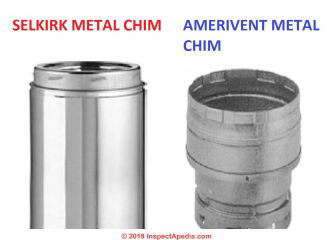
On 2020-03-18 by Carl
Can I use amerivent pipe to Selkirk ,will they lock together?
On 2020-01-03 by Sylvain
do i need to be a licence proffetionnel to install a vent liner in my chimney
On 2019-02-04 by (mod) -
There are several safety concerns in the situation you described including water damage to the heating equipment that could make it unsafe, downdrafts that could cause improper venting and risk fatal carbon monoxide poisoning, and ultimately rust damage to the equipment or flue.
I should be trivial to see which vent the rain cap belongs on by inspecting on the roof to see which one is missing. If you can't access your roof safely yourself it's time to hire mechanic with a ladder.
On 2019-02-03 by John Ulman
The wind apparantly blew my Type B Gas vent cap(0ld 3" made by Americap) off as I found it on the ground. I am not sure which vent pipe it came off. Does this present a problem as we have been having quite a bit of rain lately?
On 2018-12-09 - by (mod) -
Todd
Sorry, that's not a specification that I have seen.
I'll do some research to see if I can find any other details.
On 2018-12-09 by todd
how far away from roof vents does b vent termination need to be ? 4" diam.
On 2018-11-11 - by (mod) -
Scott
As long as you are meeting the B-vent manufacturer's fire clearance distances including from the nearest rafter, I don't know of any reason that it needs to exit the roof precisely in the middle between two rafters.
However looking at your photo I see a few items worth mentioning:
1. You will need to remove the B-vent up close to the roof underside or otherwise protect it from both damage and from sawdust and roof debris that otherwise will fall into the vent during the cuttting of the roof exit opening.
2. Your roof decking looks liike two or more generations of pine boards, possibly on an older home that originally was roofed with wood shingles. Or were those nailers overlaid with plywood? I can't quite make that out.
In any case, if the roof opening cuts through one of the original roof nailer boards, you may need to add blocking to support free end of the board.
3. The roof framing looks a bit hodge-podge to me with incomplete rafters tacked together to the left of your B-vent, abutting what may have originally been a lower ridge board with almost no visible nails - the connections could be questionable.
If I were a roofer asked to work on this roof from above, and if I had any experience with old roofs (and workers falling through them or of later being blamed for subsequent roof failures) I would want to inspect the condition of the roof framing and support from the attic side before going on the roof itself. I might then have some suggstions.
On 2018-11-11 by Scott
I have my B-Vent securely anchored to a rafter (maintaining a 1" clearance using AmeriVent Vent Pipe Hangers).
Should I relocate it directly between 2 rafters instead before I have a roofer cut the hole and install flashing, extension pipe, storm collar, and cap?
IMAGE LOST by older version of Clark Van Oyen’s Comments Box code - now fixed. Please re-post the image if you can. Sorry. Mod.
...
Continue reading at TYPE B-VENT CEILING FLOOR WALL CLEARANCES or select a topic from the closely-related articles below, or see the complete ARTICLE INDEX.
Or see TYPE B-VENT CHIMNEY FAQs - questions & answers posted originally at this page
Or see these
Recommended Articles
- ADJACENT METAL CHIMNEY SEPARATION - separation between metal chimneys and their rain caps
- CHIMNEY RE-LINING CHOICES
- CHIMNEY REPAIR METHODS
- CHIMNEY WET TIME & CORROSION for a discussion of causes of corrosion in B-vents and other metal chimneys
- HEIGHT REQUIRED for L VENTS & B VENTS
- METAL CHIMNEYS & FLUES - home
- METAL CHIMNEY INSTALLATION MANUALS
- TYPE B-VENT CHIMNEYS - home
- TYPE B-VENT IDENTIFICATION LABELS
- TYPE B VENT vs L VENT DIFFERENCES
- TYPE B-VENT ERRORS
- TYPE B-VENT CEILING FLOOR WALL CLEARANCES
- TYPE B-VENT ROOFTOP CLEARANCE
Suggested citation for this web page
TYPE B-VENT CHIMNEYS at InspectApedia.com - online encyclopedia of building & environmental inspection, testing, diagnosis, repair, & problem prevention advice.
Or see this
INDEX to RELATED ARTICLES: ARTICLE INDEX to CHIMNEYS & FLUES
Or use the SEARCH BOX found below to Ask a Question or Search InspectApedia
Ask a Question or Search InspectApedia
Questions & answers or comments about B-vents chimneys & flues: installation specifications.
Try the search box just below, or if you prefer, post a question or comment in the Comments box below and we will respond promptly.
Search the InspectApedia website
Note: appearance of your Comment below may be delayed: if your comment contains an image, photograph, web link, or text that looks to the software as if it might be a web link, your posting will appear after it has been approved by a moderator. Apologies for the delay.
Only one image can be added per comment but you can post as many comments, and therefore images, as you like.
You will not receive a notification when a response to your question has been posted.
Please bookmark this page to make it easy for you to check back for our response.
IF above you see "Comment Form is loading comments..." then COMMENT BOX - countable.ca / bawkbox.com IS NOT WORKING.
In any case you are welcome to send an email directly to us at InspectApedia.com at editor@inspectApedia.com
We'll reply to you directly. Please help us help you by noting, in your email, the URL of the InspectApedia page where you wanted to comment.
Citations & References
In addition to any citations in the article above, a full list is available on request.
- Mark Cramer Inspection Services Mark Cramer, Tampa Florida, Mr. Cramer is a past president of ASHI, the American Society of Home Inspectors and is a Florida home inspector and home inspection educator. Mr. Cramer serves on the ASHI Home Inspection Standards. Contact Mark Cramer at: 727-595-4211 mark@BestTampaInspector.com
- John Cranor [Website: /www.house-whisperer.com ] is an ASHI member and a home inspector (The House Whisperer) is located in Glen Allen, VA 23060. He is also a contributor to InspectApedia.com in several technical areas such as plumbing and appliances (dryer vents). Contact Mr. Cranor at 804-873-8534 or by Email: johncranor@verizon.net
- Thanks to Luke Barnes for suggesting that we add text regarding the hazards of shared chimney flues. USMA - Sept. 2008.
- Arlene Puentes [Website: www.octoberhome.com ] , an ASHI member and a licensed home inspector in Kingston, NY, and has served on ASHI national committees as well as HVASHI Chapter President. Ms. Puentes can be contacted at ap@octoberhome.com
- Roger Hankeyis principal of Hankey and Brown home inspectors, Eden Prairie, MN, technical review by Roger Hankey, prior chairman, Standards Committee, American Society of Home Inspectors - ASHI. 952 829-0044 - hankeyandbrown.com
- NFPA 211 - Standards for Chimneys & Fireplaces, NFPA 211: Standard for Chimneys, Fireplaces, Vents, and Solid Fuel-Burning Appliances, 2006 Edition (older editions and standards are found at the same bookstore)
- NFPA #211-3.1 1988 - Specific to chimneys, fireplaces, vents and solid fuel burning appliances.
- NFPA # 54-7.1 1992 - Specific to venting of equipment with fan-assisted combustion systems.
- GAMA - Gas Appliance Manufacturers' Association has prepared venting tables for Category I draft hood equipped central furnaces as well as fan-assisted combustion system central furnaces.
- National Fuel Gas Code, an American National Standard, 4th ed. 1988 (newer edition is available) Secretariats, American Gas Association (AGA), 1515 Wilson Blvd., Arlington VA22209, and National Fire Protection Association (NFPA), Batterymarch Park, Quincy MA 02269. ANSI Z223.1-1988 - NFPA 54-1988. WARNING: be sure to check clearances and other safety guidelines in the latest edition of these standards.
- Fire Inspector Guidebook, A Correlation of Fire Safety Requirements Contained in the 1987 BOCA National Codes, (newer edition available), Building Officials and Code Administrators International, Inc. (BOCA), Country Club HIlls, IL 60478 312-799-2300 4th ed. Note: this document is reissued every four years. Be sure to obtain the latest edition.
- Uniform Mechanical Code - UMC 1991, Sec 913 (a.) Masonry Chimneys, refers to Chapters 23, 29, and 37 of the Building Code.
- New York 1984 Uniform Fire Prevention and Building Code, Article 10, Heating, Ventilating, and Air Conditioning Requirements
- New York 1979 Uniform Fire Prevention & Building Code, The "requirement" for 8" of solid masonry OR for use of a flue liner was listed in the One and Two Family Dwelling Code for New York, in 1979, in Chapter 9, Chimneys and Fireplaces, New York 1979 Building and Fire Prevention Code:
- "Top Ten Chimney (and related) Problems Encountered by One Chimney Sweep," Hudson Valley ASHI education seminar, 3 January 2000, contributed by Bob Hansen, ASHI
- Chimney Inspection Checklist, Carson Dunlop, Associates, Toronto, Ontario
- "Rooftop View Turns to Darkness," Martine Costello, Josh Kovner, New Haven Register, 12 May 1992 p. 11: Catherine Murphy was sunning on a building roof when a chimney collapsed; she fell into and was trapped inside the chimney until rescued by emergency workers.
- "Chimneys and Vents," Mark J. Reinmiller, P.E., ASHI Technical Journal, Vol. 1 No. 2 July 1991 p. 34-38.
- "Chimneys and Vents", 789 CMR 68.00 Massachusetts Building Code, web search 10/15/2010, original source:
http://www.mass.gov/Eeops/docs/dps/780%20CMR/780068.pdf 03/23/2007
780 CMR: STATE BOARD OF BUILDING REGULATIONS AND STANDARDS THE MASSACHUSETTS STATE BUILDING CODE - quoting:
6801.11 Multiple-Appliance Venting Systems. Two or more listed and labeled fossil fuel-fired appliances shall not be connected to a common natural draft venting system unless permitted per applicable requirements of 248 CMR or 527 CMR. For solid fuel-burning appliances, see 780 CMR 6801.12. - Chimneys and Vents, Chapter 18, M1801,model building code - [on file as Code_Chim_Res_C_18.pdf] - widely used by U.S. & Canadian Municipalities,
- "Model DFS L-Vent / Type B Gas Vent Installation Instructions", Selkirk Corporation, 5030 Corporate Exchange Blvd., Grand Rapids MI 49512, Tel: 800-433-6341 & Selkirk Canada Corporation, PO Box 526, Depot 1, Hamilton ON L8L 7X6, 888-735-5475, web search 10/15/2010, original source: www.mass.gov/Eeops/docs/dps/780%20CMR/780068.pdf
- "Type L Temperature Venting Systems [on file as L_Vent_Metal_Fab.pdf] - ", Installation and Maintenance Instructions, Metal-Fab Inc., PO Box 1138, Sichita KS 67201, 316-943-2351, Email: info@mtl-fabinc.com website: www.mtl-fabinc.com
- "Type L Vent Vent for Oil/Gas Fired Appliances, Installation and Maintenance Manual", Energy Vent Ltd., 241 Arvin Ave., Stoney Creek Ontario Canada L8E 2L9, web search 10/15/2010 original source: www.selkirkcorp.com/WorkArea/downloadasset.aspx?id=2380 www.selkirkcorp.com/WorkArea/downloadasset.aspx?id=1802
- Ceramic Roofware, Hans Van Lemmen, Shire Library, 2008, ISBN-13: 978-0747805694 - Brick chimneys, chimney-pots and roof and ridge tiles have been a feature of the roofs of a wide range of buildings since the late Middle Ages. In the first instance this ceramic roofware was functional - to make the roof weatherproof and to provide an outlet for smoke - but it could also be very decorative.
The practical and ornamental aspects of ceramic roofware can still be seen throughout Britain, particularly on buildings of the Victorian and Edwardian periods. Not only do these often have ornate chimneys and roof tiles but they may also feature ornamental sculptures or highly decorative gable ends. This book charts the history of ceramic roofware from the Middle Ages to the present day, highlighting both practical and decorative applications, and giving information about manufacturers and on the styles and techniques of production and decoration.
Hans van Lemmen is an established author on the history of tiles and has lectured on the subject in Britain and elsewhere. He is founder member and presently publications editor of the British Tiles and Architectural Ceramics Society. - Chimney Inspection Checklist, Carson Dunlop, Associates, Toronto, Ontario
- Chimney & Stack Inspection Guidelines, American Society of Civil Engineers, 2003 - These guidelines address the inspection of chimneys and stacks. Each guideline assists owners in determining what level of inspection is appropriate to a particular chimney and provides common criteria so that all parties involved have a clear understanding of the scope of the inspection and the end product required. Each chimney or stack is a unique structure, subject to both aggressive operating and natural environments, and degradation over time. Such degradation may be managed via a prudent inspection program followed by maintenance work on any equipment or structure determined to be in need of attention. Sample inspection report specifications, sample field inspection data forms, and an example of a developed plan of a concrete chimney are included in the guidelines. This book provides a valuable guidance tool for chimney and stack inspections and also offers a set of references for these particular inspections.
- Fireplaces, a Practical Design Guide, Jane Gitlin
- Fireplaces, Friend or Foe, Robert D. Mayo
- NFPA 211 - Standards for Chimneys & Fireplaces, NFPA 211: Standard for Chimneys, Fireplaces, Vents, and Solid Fuel-Burning Appliances, 2006 Edition (older editions and standards are found at the same bookstore)
- Principles of Home Inspection: Chimneys & Wood Heating, in (Principles of Home Inspection), Carson Dunlop, Associates, Toronto, Ontario
- NFPA 211 - 3-1.10 - Relining guide for chimneys
- NFPA 211 - 3-2 - Construction of Masonry Chimneys
- NFPA 211 - 3-3 - Termination Height for chimneys
- NFPA 211 - 3-4 - Clearance from Combustible Material
- NFPA 54 - 7-1 - Venting of Equipment into chimneys
- Brick Institute of America - Flashing Chimneys
Brick Institute of America - Proper Chimney Crowns
Brick Institute of America - Moisture Resistance of Brick - American Gas Association - New Vent Sizing Tables
- Chimney Safety Institute of America - Chimney Fires: Causes, Effects, Evaluation
- National Chimney Sweep Guild - Yellow Pages of Suppliers
- In addition to citations & references found in this article, see the research citations given at the end of the related articles found at our suggested
CONTINUE READING or RECOMMENDED ARTICLES.
- Carson, Dunlop & Associates Ltd., 120 Carlton Street Suite 407, Toronto ON M5A 4K2. Tel: (416) 964-9415 1-800-268-7070 Email: info@carsondunlop.com. Alan Carson is a past president of ASHI, the American Society of Home Inspectors.
Thanks to Alan Carson and Bob Dunlop, for permission for InspectAPedia to use text excerpts from The HOME REFERENCE BOOK - the Encyclopedia of Homes and to use illustrations from The ILLUSTRATED HOME .
Carson Dunlop Associates provides extensive home inspection education and report writing material. In gratitude we provide links to tsome Carson Dunlop Associates products and services.


